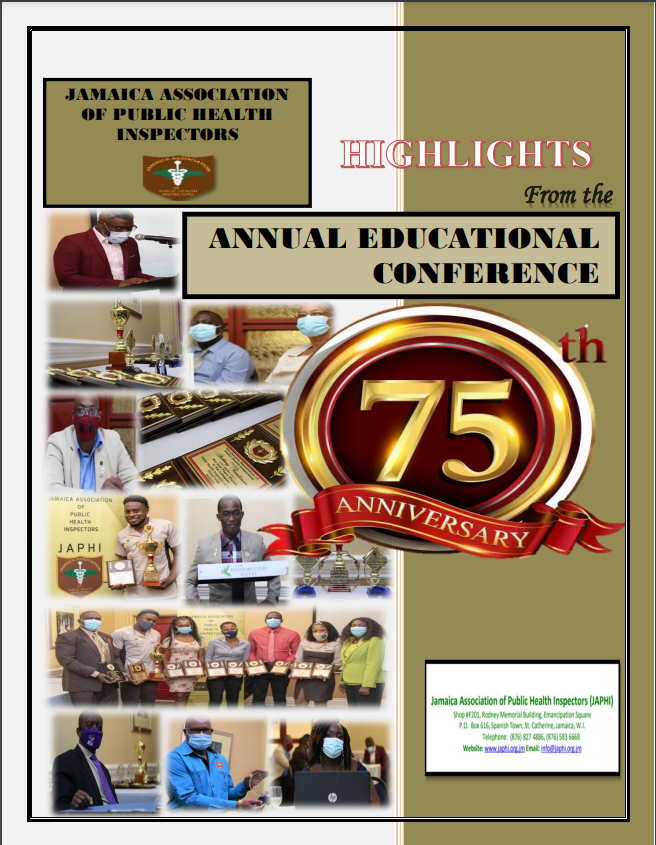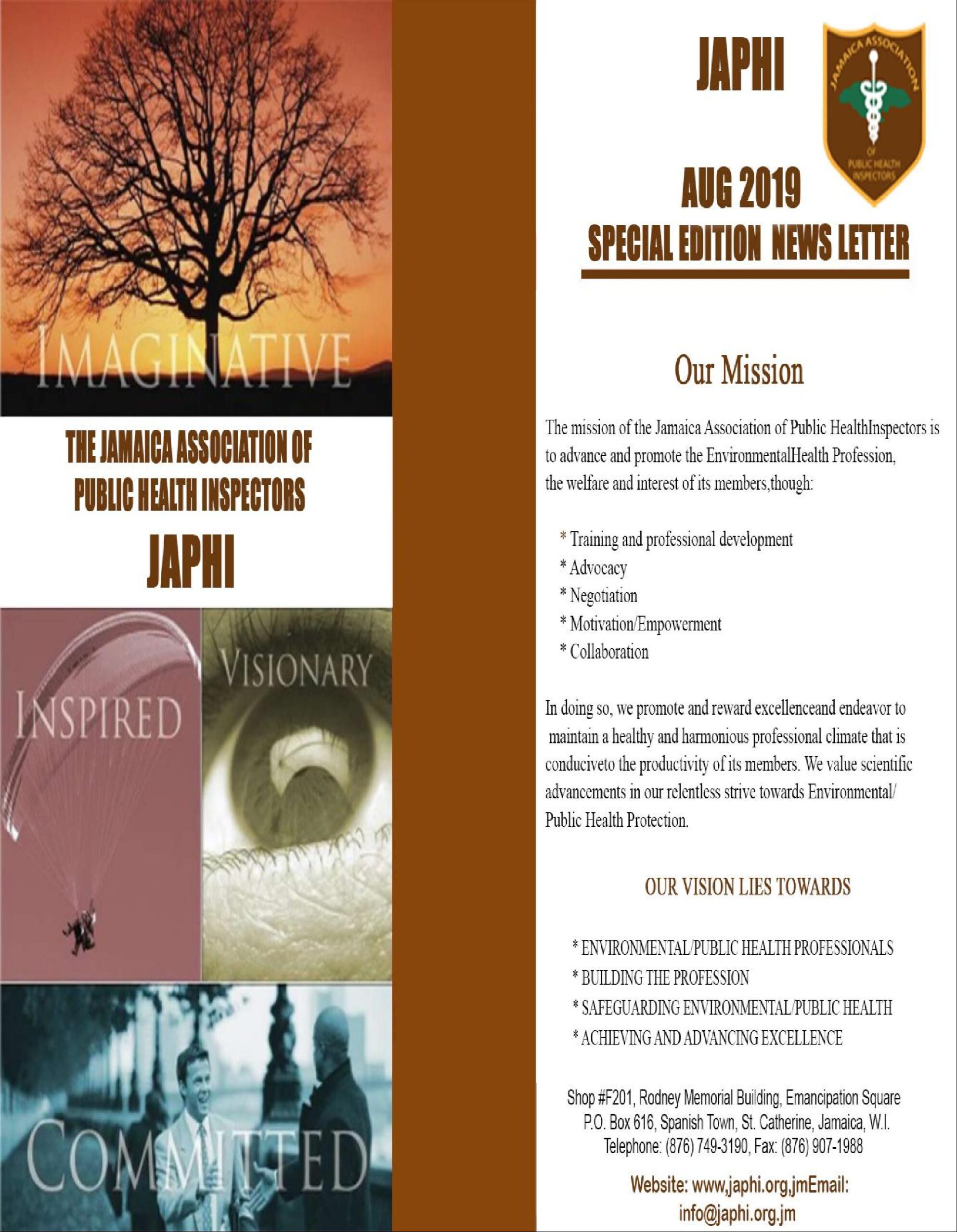ARTICLES & BLOGS
Read Our Articles
You can submit an article relevant to Public Health in Jamaica addition to our site.
President's Christmas Message
St James Chief Public Health Inspector Lauds Labor Day Support From Municipal Corporation
Mr. Wallace stated that the various teams came out and did their best in the renovating of the entire clinic and even the outside.
The Municipal Corporation representatives from the Road and Works Department joined forces with members of the Jamaica Defense Force’s soldiers in constructing a Ramp for the disabled an extension of the parking lot and driveway.
The Public Health Inspector stated that starting tomorrow, he is sure that the staff members of the clinic will feel much more relaxed and comfortable in their newly renovated home.
By: Henry Buckner
JAPHI’S Corner (Recycling and Composting)
What is Recycling?
Effective recycling starts with household (or the place where the waste was created). In many serious countries, the authorities help households with bins with labels on them. Households then sort out the waste themselves and place them in the right bags for collection. This makes the work less difficult.
What is Composting?
Composting is nature’s process of recycling decomposed organic materials into a rich soil known as compost. Backyard composting is an acceleration of the same process nature uses. Composting allow organic waste to return nutrients back into the soil in order for the cycle of life to continue. Finished compost looks like soil–dark brown, crumbly and is rich in nutrients. It can be use in farming as fertilizer.
Our role as Public Health Inspectors is to sensitize the populace on recycling and composting in an effort to significantly reduce the quantity of solid waste put out by householders for disposal. Yes, the infrequent collection of solid waste throughout communities is a serious problem but community members should be made aware of alternative methods of disposal. This will also reduce greatly the number of plastics, Styrofoam, card board boxes and even tires that end up in our gullies, drains and on our coastal fronts resulting in flooding, mosquito breeding and damage to our coral reef and a reduction in marine life.
The Government/ Ministry of Local Government can adopt any or a combination of the following recommendations:
Management of Old Tires
- Identify storage area at an appropriate disposal site for tires.
- Implement and maintain a system/s for management of tires i.e. tires should be shredded or covered with earth or plotted or stacked and covered to prevent collecting water which reduce the breeding of mosquitoes.
- Revised the National Solid Waste Management Policy, May 2000 (Ministry of Local Government Youth and Community Development) to allow tire shop operators and garages to collect a fee from motor vehicle operators for disposal of their used tires to create a revolving fund for the maintenance of a tire management collection system.
- Embark on an education campaign to sensitize all stakeholders.
Management of Plastics
- Education campaign to sensitize all stakeholders i.e. plastics should be sorted by householder, commercial entities and Institutions and are collected separately by the Municipal Collection System. This should be in partnership with the companies involved in the sale of their products in plastic containers and such like (Public/Private partnership).
- Embark on an education campaign to sensitize all stakeholders.
BY
JAPHI TEAM
Is it really that? Who Did It? The Rat? Or The Cat?
Leptospirosis is a bacterial zoonotic disease of increasing worldwide prevalence and distribution. It is caused by the organism Leptospira bacteria and occurs in tropical areas with high rainfall.
Many decades ago rats were implicated in the bubonic plague killing millions of people. But are rats the only culprits? Pathogenic leptospirae are widespread in nature and shed in urine of many wild and domestic animals (reservoir). It has been isolated from mammalian and amphibian species including bats, frogs and toads respectively.
According to World Health Organization (WHO) people who are engage in agriculture and animal husbandry have higher risk of leptospirosis in comparison to other occupation. Leptospirosis is transmitted to humans through ingestion (eating or drinking), inhalation (breathing) or through broken skin or through contaminated water sources, food, or even bedding. Stagnant or slow moving water provides a suitable habitat for Leptospira. As a result, disease outbreaks often increase during periods of flooding. In dry areas infections are more common around water sources.
Infected persons typically present with sudden onset of fever, chills, and headache. These signs and symptoms are nonspecific and also occur with other causes of acute febrile syndrome that could also be caused by influenza, dengue fever, or malaria. The case definition for leptospirosis states that it is characterized by fever, headache, myalgia of calves and/or thighs, conjunctival suffusion, meningitis and jaundice (National Surveillance Manual). A positive diagnosis can be made through a blood test. A blood sample of the suspected case/s is drawn and sent to the laboratory where a microscopic Agglutination test is performed. In Jamaica and other developing and developed countries such as Brazil and United States of America respectively, Leptospirosis remains under- estimated for a number of reasons, these include the lack of clinical suspicion, lack of a notification system or notification of the disease is not mandatory and barriers in diagnostic capacity. Is it really leptospirosis? Could the cow or the goat be the culprits? Furthermore, it remains largely under-diagnosed or mis-diagnosed with other febrile illness and there is no evidence to say that the serovar responsible for leptospirosis cases is carried by rats or other animals.
The disease continues to have major impact on people living in urban and rural areas of developing countries within estimatable morbidity and mortality. Currently funding for research and control efforts is haphazard and will not be effective until major issues in the field are addressed.
The existence of large numbers of animal reservoirs and route of disease transmission make activities in prevention and control of leptospirosis difficult. Therefore, further research is needed to gain more pathological information of the disease (leptospirosis) to prevent deaths that could be prevented with timely treatment after early and accurate diagnosis of the disease. The ONE HEALTH approach which encourages interdisciplinary effort could be the answer where veterinary medicine, human medicine and environmental health collaborate by improving laboratory capacity and conducting research and sharing information on diseases such as leptospirosis i.e. the serovar implicated in the transmission of leptospirosis is same in rats or animals, in order to affect timely and effective interventions.
BY
Michael Myles
JAPHI Executive Member
St. Elizabeth
“Be Bold, Be a Beacon of Light”
View Our Newsletter
Read Our Blog
GREASE!!!!Where does it go????
Aug 6, 2020 | Blog
Environmental impact Fat, oil and grease cause major problems to drains and sewers. When they are disposed of down kitchen sinks or drains they cause blockages; when they enter rainwater pipes or gullies they cause pollution in streams and rivers. History...
read moreRead Post Facebook
Jamaica Association of Public Health Inspectors
Public Health Inspector, Natassia Rowe from the St. Elizabeth Health Department sensitizes teachers
Southern Regional Health Authority
The Jamaica Association of Public Health Inspectors is the premier organization
Jamaica Association of Public Health Inspectors
Take the time out to watch this video and be informed as Chief Public Health Inspector (CPHI)
Jamaica Association of Public Health Inspectors
As we grapple the fight in this pandemic, Public Health Inspectors are on the forefront. Did you know?






